Complete Solutions to Aldehyde, Ketones And Carboxylic Acids of chapter ALDEHYDE, KETONES AND CARBOXYLIC ACIDS of Class 12 book with complete answers and questions
| Class 12 | CHEMISTRY |
| Chapter | ALDEHYDE, KETONES AND CARBOXYLIC ACIDS |
| NCERT EXEMPLAR | Aldehyde, Ketones And Carboxylic Acids |
| Number Of Questions | 50 |
| Academic Year | 2023-24 |
Addition of water to alkyness occurs in acidic medium and in the presence of `Hg^(2+)` ions as a catalyst. Which of the following products will be formed on additon of water to but-1-yne under these conditions?
02:08View SolutionWhich of the following compounds is the most reactive towards electrophilic addition reactions?
02:04View SolutionThe correct order of increasing acidic strength is
03:01View SolutionCompound `Ph-O-overset(O)overset(||)(C)-Ph` can be prepared by the reaction of _____________.
04:50View SolutionThe reagent with which both acetaldehyde and acetone react easily is
02:04View SolutionCannizzaro's reaction is not given by
01:53View SolutionWhich product is formed when the compound is treated with concentrated aqueous KOH solution ?
01:31View Solution`CH_(3) - C -= CHoverset(40%H_(2)SO_(4))underset(1%HgSO_(4))rarrAoverset("isomerisation")rarr`

Structure of A and type of isomerism in the above reaction respectively are02:36View SolutionComplete the following reaction sequence :
`CH_(3)-overset(O)overset(||)C-CH_(3)overset((i)CH_(3)MgBr)underset((ii)H_(2)O)rarr(A)overset("Na metal")underset("ether")rarr(B)overset(CH_(3)-Br)rarr(C)`04:11View SolutionWhich is the most suitable reagent for the following conversion ?
`CH_(3)-CH=CH-CH_(2)-overset(O)overset(||)(C)-CH_(3)to`
`CH_(3)-CH=CH-CH_(2)-overset(O)overset(||)(C)-OH`04:45View SolutionWhich of the following compound will give butanone on oxidation with alkaline `KMnO_(4)` solution ?
03:06View SolutionIn Clemmensen reduction, carbonyl compound is treated with …….
01:13View SolutionWhich of the following will undergo aldol condensation ?
04:20View SolutionTreatement of compound `Ph-O-overset(O)overset(||)(C)-Ph`
with NaOH solution yields02:09View SolutionWhich of the following conversion can be carried out by Clemmensen reduction ?
03:20View SolutionThrough which of the following reactions number of carbon atoms can be increased in the chain ?
05:07View SolutionBenzophenone can be obtained by ……
02:05View SolutionWhich of the following is the correct represetation for intermediate of nucleophilic addition reaction to the given carbonyl compound (A) ?
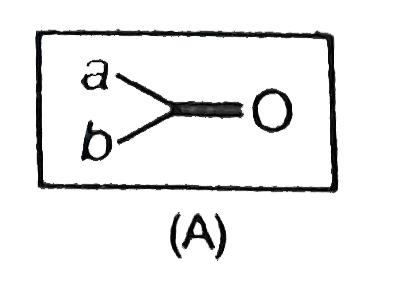 03:21View Solution
03:21View SolutionWhy is there a large difference in the boiling points of butanal and butan-1-ol ?
04:18View SolutionWrite a test to differentiate between pentan-2-one and pentan-3-one.
04:06View SolutionGive the IUPAC names of the following compounds.
(a)
(c) `CH_(3)-CH_(2)-underset(O)underset(||)C-CH_(2)-CHO` , (d) `CH_(2)-CH=CH-CHO`03:30View SolutionGive the structure of the following compounds :
(i) 4-Nitropropiophenone
(ii) 2-Hydroxycyclopentanecarbaldehyde
(iii) Phenyl acetaldehyde.02:01View SolutionWrite IUPAC names of the following structures
 02:18View Solution
02:18View SolutionBenzaldehyde can be obtained from benzalchloride. Write reactions for obtaining benzalchloride and then benzaldehyde from it.
02:36View SolutionName the electrophile produced in the reaction of benzene with benzoyl chloride in the presence of anhydrous `AlCl_(3)`. Name the reaction also.
05:36View SolutionOxidation of ketones involves carbon-carbon bond cleavage. Name the products formed on oxidation of 2, 5-dimethylhexan-3-one.
04:46View SolutionArrange the following in decreasing order of their acidic strength and give reason for your answer.
`CH_(3)CH_(2)OH, CH_(3)COOH, ClCH_(2)COOH, FCH_(2)COOH, C_(6)H_(5)CH_(2)COOH`03:40View SolutionWhat product will be formed on reaction of propanal with 2-methylpropanal in the presence of NaOH? Write the name of the reaction also.
09:23View SolutionCompound 'A' is prepared by oxidation of compound 'B' with alkaline `KMnO_(4)`. Compound 'A' on reduction with lithium aluminium hydride gets converted back to compound 'B'. When compound 'A' is heated with compound 'B' in the presence of `H_(2)SO_(4)`, it produces fruity smell of compound 'C'. To which family, the compounds 'A', 'B' and 'C' belong to ?
04:03View SolutionArrange the following in decreasing order of their acidic strength. Give explanation for the arrangement.
`C_(6)H_(5)COOH, FCH_(2)COOH, NO_(2)CH_(2)COOH`03:18View SolutionAlkenes
 and carbonyl compounds
and carbonyl compounds  both contain a `pi` bond but alkenes show electrophilic addition reactions whereas carbonyl compounds show nucleophilic addition reactions. Explain.05:09View Solution
both contain a `pi` bond but alkenes show electrophilic addition reactions whereas carbonyl compounds show nucleophilic addition reactions. Explain.05:09View SolutionCarboxylic acids contain carbonyl group but do not show the nucleophilic addition reactions like aldehydes or ketones. Why?
03:46View SolutionIdentify the compounds A, B and C in the following reaction :
`CH_(3)-Broverset(Mg//ether)rarr(A)overset((i)CO_(2))underset((i)"Water")rarr(B)overset(CH_(3)OH//H)underset(Delta)rarr(C)`03:31View SolutionWhy are carboxylic acids more acidic than alcohols or phenols although all of them have hydrogen atom attached to a oxygen atom (-O-H)?
04:46View SolutionComplete the following reaction sequence :
`CH_(3)-overset(O)overset(||)C-CH_(3)overset((i)CH_(3)MgBr)underset((ii)H_(2)O)rarr(A)overset("Na metal")underset("ether")rarr(B)overset(CH_(3)-Br)rarr(C)`04:11View SolutionEthylbenzene is generally prepared by acetylation of benzene followed by reduction and not by the direct alkylation of benzene. Think of a possible reason.
05:23View SolutionCan Gattermann-Koch reaction be considered similar to Friedel Craft's acylation ? Discuss.
05:30View SolutionMatch the common names given in Column I with the IUPAC names given in Column II.
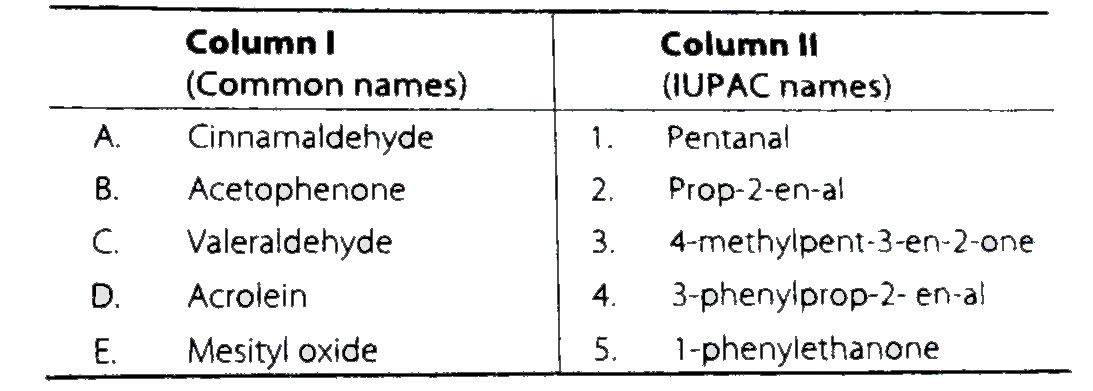 05:44View Solution
05:44View SolutionMatch the acids given in Column I with their correct IUPAC names given in Column II.
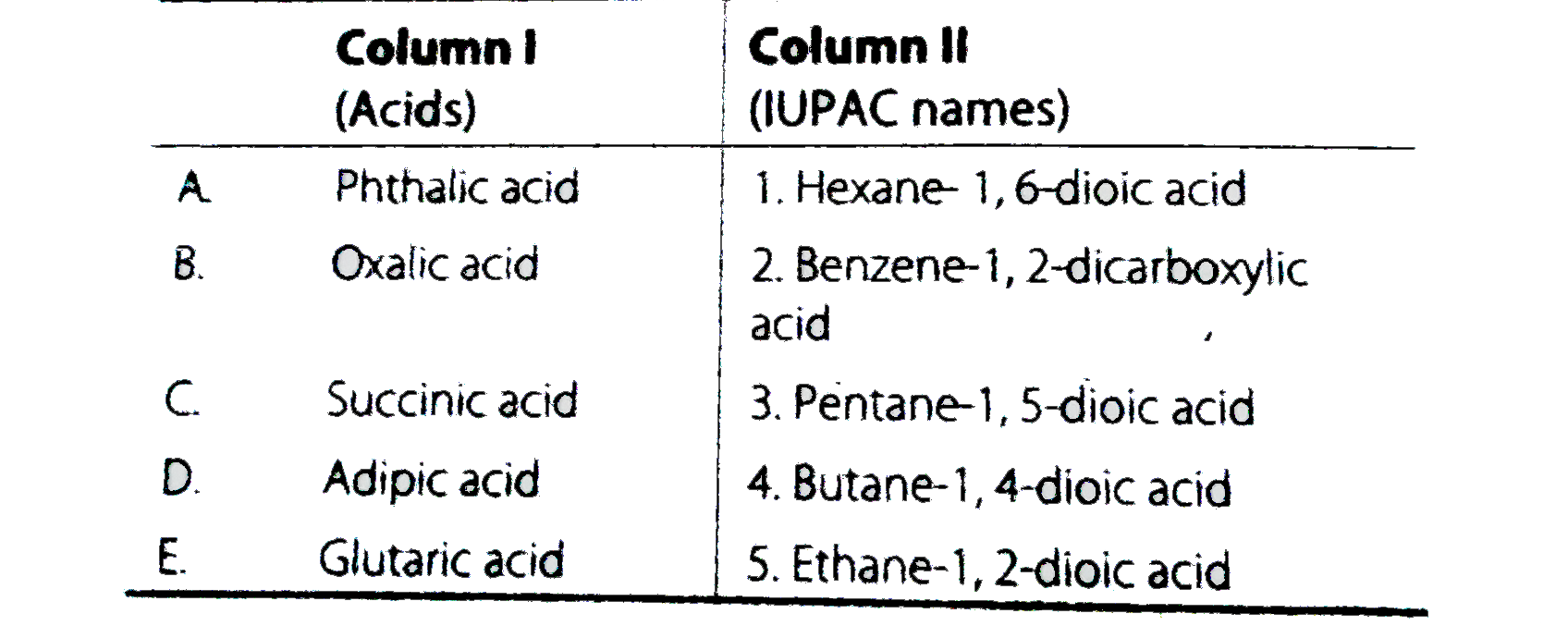 04:11View Solution
04:11View SolutionMatch the reactions given in Column I with the suitable reagents given in Column II.
 06:30View Solution
06:30View SolutionMatch the example given in Column I with the name of the reaction in Column II.
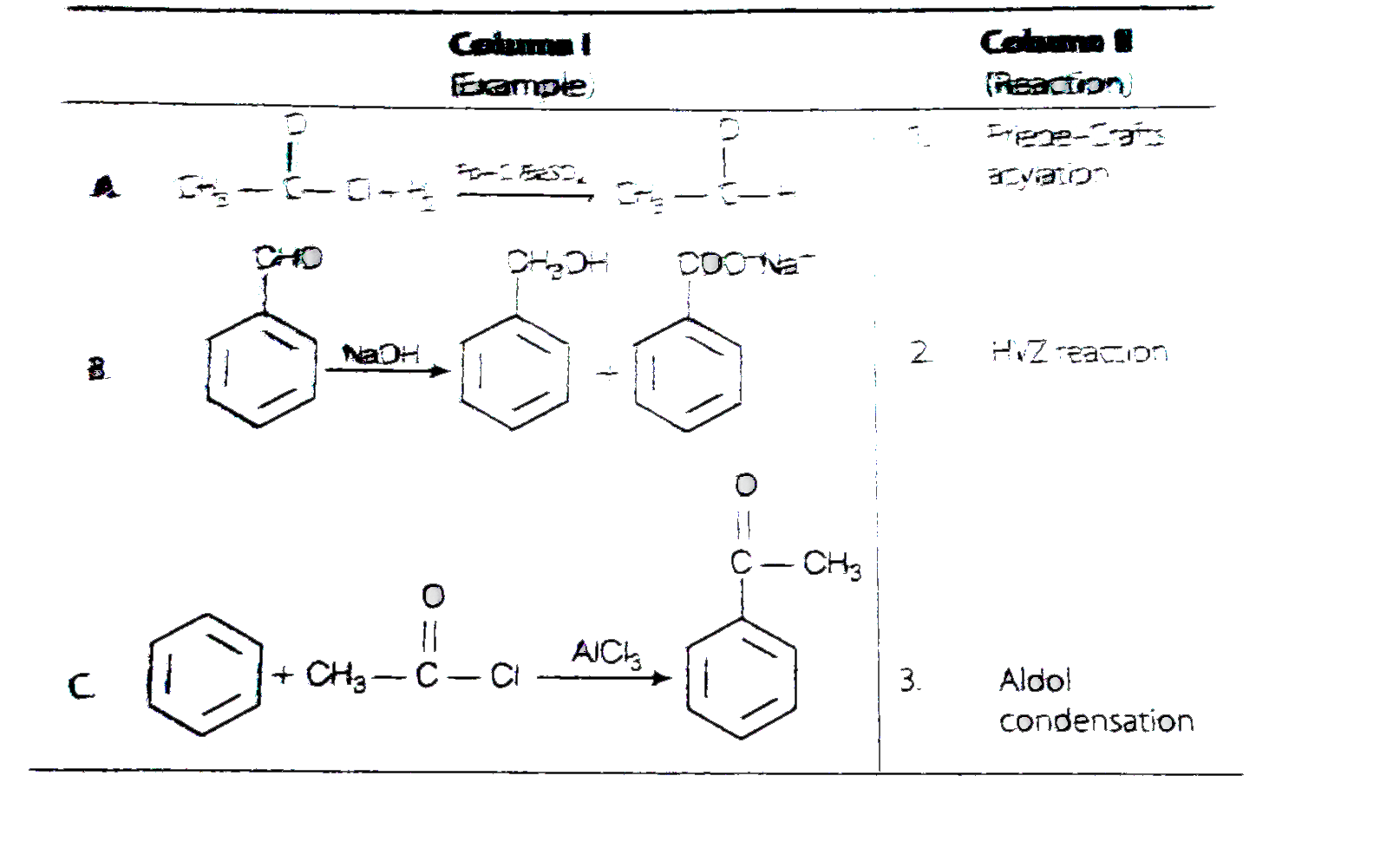
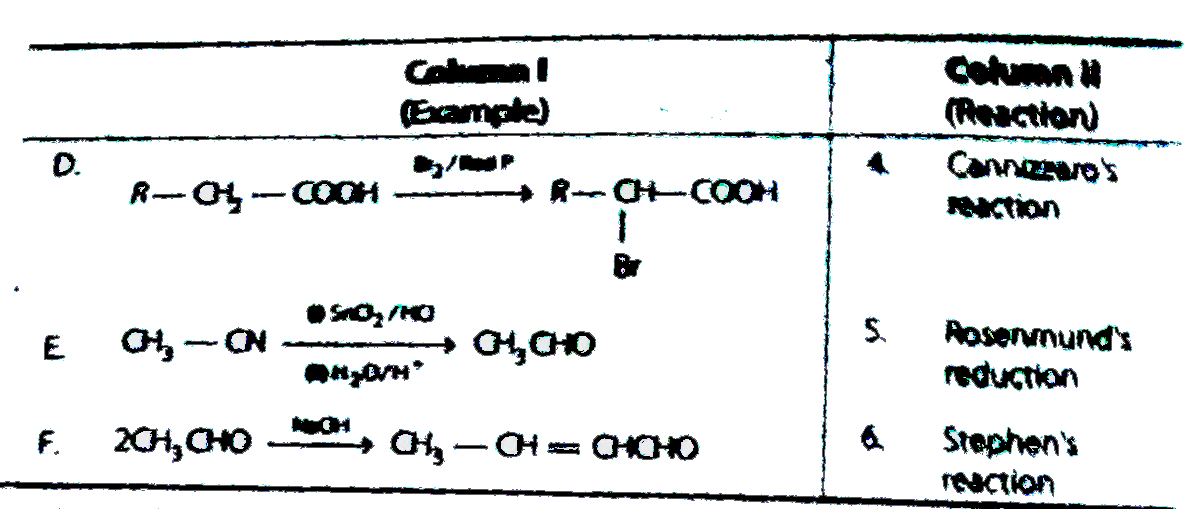 03:48View Solution
03:48View SolutionAssertion (A) Formaldehyde is a planar molecule.
Reason (R) It contains `sp^(2)` hybridised carbon atom.02:02View SolutionAssertion (A) compound containing -CHO group are easily oxidised to corresponsing carboxylic acids
Reason (R) : Carboxylic acids can be reduced to alcohols by treatement with `LiAlH_(4)`03:43View SolutionAssertion (A) The `alpha`-hydrogen atom in carbonyl compounds is less acidic.
Reason (R) The anion formed after the loss of `alpha`-hydrogen atom is resonance stabilised.03:11View SolutionAssertion : Aromatic aldehydes and formaldehyde undergo Cannizzaro reaction
Reason : Aromatic aldehydes are almost as reactive as formaldehyde.02:45View SolutionAssertion (A) Aldehydes and ketones, both react with Tollen's reagent to form silver mirror.
Reason (R) Both, aldehydes and ketones contain a carbonyl group.02:56View SolutionAn alkene 'A' (molecular formula `C_(5)H_(10)`) on ozonolysis gives a mixture of two compounds 'B' and 'C'. Compound 'B' gives positive Fehling's test and also forms iodoform on treatement with `I_(2)" and "NaOH`. Compound 'C' does not give Fehling's test but forms iodoform. Identify the compounds A, B and C. Write the reaction for ozonolysis and formation of iodoform from B and C.
11:50View SolutionAn aromatic compound 'A' (Molecular formula `C_(8)H_(8)O)`) gives positive 2, 4-DNP test. It gives a yellow precipitate of compound 'B' on treatment with iodine and sodium hydroxide solution. Compound 'A' does not give Tollen's or Fehling's test. On drastic oxidation with potassium permanganate, it forms a carboxylic acid 'C' (Molecular formula `C_(7)H_(6)O_(2)`), which is also formed along with the yellow compound in the above reaction. Identify A, B and C and write all the reactions involved.
08:34View SolutionWrite down functional isomers of a carbonlyl compound with molecular formula `C_(3)H_(6)O`. Which isomer will react faster with HCN and why ? Explain the mechanism of the reaction also. Will the reaction lead to the completion with the conversion of whole reactant into product under reaction conditions ? If a strong acid is added to the reaction mixture, what will be the effect on concentration of the product and why?
09:23View SolutionWhen liquid 'A' is treated with a freshly prepared ammoniacal silver nitrate solution it gives bright silver mirror. The liquid forms a white crystalline solid on treatment with sodium hydrogen sulphate. Liquid 'B' also forms a white crystalline solid with sodium hydrogen sulphate. but it does not give test with ammoniacal silver nitrate. Which of the two liquids is aldehyde? Write the chemical equations of these reactions also.
03:20View Solution
Aldehyde, Ketones And Carboxylic Acids questions and complete solutions for chapter ALDEHYDE, KETONES AND CARBOXYLIC ACIDS of CHEMISTRY of Class 12
